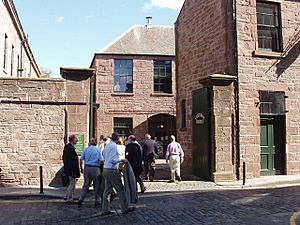Verdant Works facts for kids

Entrance to Verdant Works
|
|
| Established | 16 September 1996 |
|---|---|
| Location | West Henderson's Wynd, Blackness, Dundee, Scotland |
| Owner | Dundee Heritage Trust |
Verdant Works, also known as Scotland's Jute Museum, is a fascinating museum in Dundee, Scotland. It used to be a busy jute mill, which is a factory where jute fabric was made. The Dundee Heritage Trust bought the old factory in 1991.
They worked hard to fix up the buildings. On September 16, 1996, Prince Charles officially opened it as a museum. Verdant Works now tells the amazing story of the textile industry. This industry was once super important to Dundee's economy.
Contents
A Special Historic Building
The Verdant Works building is very old and important. In 1987, it was given "Category A listed building" status by Historic Scotland. This means it's one of the most important buildings in Scotland. It has great architectural value.
The museum is a rare example of an old factory built around a courtyard. Many of its original parts and design are still there. It's one of the few old industrial buildings in Dundee that looks much like it did in the 1800s.
Exploring the Museum
Verdant Works is the only museum in the United Kingdom completely dedicated to jute. It shares the history of Dundee's textile industries. The main focus is on jute and linen production.
Dundee's Jute Story
Making textiles was the biggest industry in Dundee for many years. By the late 1800s, about 50,000 people worked in textile factories. This was half of all the working people in the city! Many more thousands worked in related jobs. These included shipbuilding, transportation, and engineering.
Dundee supplied most of the world's jute products back then. This made the city very important for both Scottish and British history.
What You Can See
The museum's jute collections cover the entire history of the industry. You can learn about how jute was made. You'll also see how new products were developed. The museum shows the final products and how quality was checked.
You can also learn about the machines used. There are displays about the industry's connections to India. Most importantly, you can discover what life was like for the workers.
The museum has many interesting objects. These include machinery patterns, jute and flax products, and small tools. There are also technical drawings and testing equipment.
Archives and Awards
The museum also keeps old records and photos from different mills. These show what life was like for the workers. They are very valuable for learning about history. The collections include items about industrial history, social history, and even old business papers.
Verdant Works is a highly respected museum. It has won many awards from Scotland and other countries. Visit Scotland has given it a 5-star rating for tourists. In 2008, its Jute Collection was named a "Recognised Collection of National Significance." This means it's very important to Scotland's heritage.
The High Mill
In September 2015, a new part of the museum opened. This section is in the High Mill building. The High Mill was built in 1833. It is the oldest part of the entire Verdant Works complex.
This building was carefully restored. It was turned into an open gallery space. The Heritage Lottery Fund helped pay for this big project.

